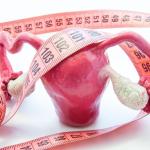Why are fibroids painful?
Why do fibroids cause pain? Fibroids, by definition, are a benign tumor of muscular and fibrous tissues, typically developing in the wall of the uterus, as per the Oxford dictionary. If you’re wondering why your fibroids are so painful, know that not all women experience fibroid pain, but for some, it can be crippling. Uterine fibroids can cause chronic stomach pain in certain women, which makes it difficult for them to move or carry out daily duties.
Can fibroids hurt? Do fibroids hurt all the time? Many women have admitted that they have been unable to go to work, exercise, or take part in activities with friends or family due to significant pelvic discomfort or severe cramps. For a lot of women, fibroid pain can be very severe and hurt until they get treatment.
Besides menstrual bleeding (periods) and continued periods, other areas of pain can be:

- Pelvic pain
- Painful and heavy menstruation
- Pain during intercourse
- Lower back or leg pain
Think you might have fibroids based off these? Take our symptom quiz.
If you’re wondering “Why is my fibroid painful?” It’s important to note that each woman can experience fibroid pain differently, at least in terms of intensity.
Does fibroid pain come and go? The pain could be constant or only present during intercourse or menstruation.
How painful are fibroids? It might hurt sharply or barely at all. Additionally, your fibroids’ location, size, and quantity can affect your symptoms. If you do have fibroid pain symptoms, you might have mild pain that can be managed with over-the-counter analgesics or severe pain that keeps you at home or even in bed. Others aren’t so lucky.
So why do fibroids hurt? The short answer is this: “The pain and pressure symptoms associated with uterine fibroids generally result from the weight of the fibroid itself pressing or resting on the pelvic organs, rather than the fibroid itself hurting. Ultrasound exams are helpful to evaluate the size and location of a fibroid. They can help your doctor to know if the fibroid is responsible for the pain you may be having,” says Holly Ernst, a physician assistant.1
The bottom line is if they’re smaller, they’re less likely to hurt, the same goes for if you don’t have many; however, if you have a lot of big fibroids? They’ll more than likely hurt. Like any disease or medical condition, uterine fibroid pain usually depends on the person and their pain tolerance levels.
Many women may believe that their suffering and discomfort are common.
If your fibroids are negatively affecting your life, there are therapeutic alternatives. Women often think that the only treatment for this problem is a hysterectomy. However, various therapies are available to help you manage your fibroid pain. We want you to know that a hysterectomy is not your only option to deal with your fibroid pain, and there are treatment options available at your disposal.
If you’re unsure if you should seek fibroid treatment, think about whether uterine fibroid symptoms affect your self-esteem, social life, profession, or personal relationships. Heavy bleeding, bleeding in between periods, frequent urination, uncomfortable intercourse, low energy, and pelvic pain are some symptoms that may be present.
Uterine Fibroid Embolization
We at USA Fibroid Centers believe it’s time take your body and life back. We offer an outpatient, minimally invasive procedure to alleviate fibroid pain called Uterine Fibroid Embolization (UFE). UFE can eliminate your symptoms, protect your uterus, and immediately return you to normal activities. You can go home the same day as the surgery, which only takes 30 to 45 minutes and does not require an extended hospital stay or recuperation period. Within one to two weeks, the majority of women are back to their regular daily schedules.
Call USA Fibroid Centers at 855.615.2555 or fill out our online scheduling form. You can schedule a doctor visit if you prefer telemedicine. Interested in UFE? Let’s connect to find out if you’re a good fit.
https://www.healthline.com/health/womens-health/fibroid-pain#:~:text=The%20pain%20and%20pressure%20symptoms,and%20location%20of%20a%20fibroid.



